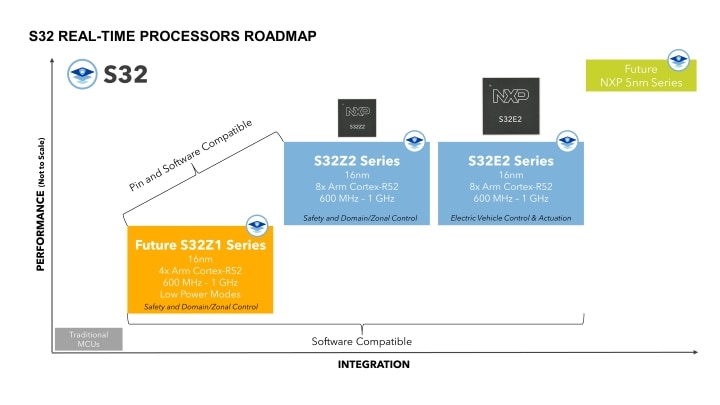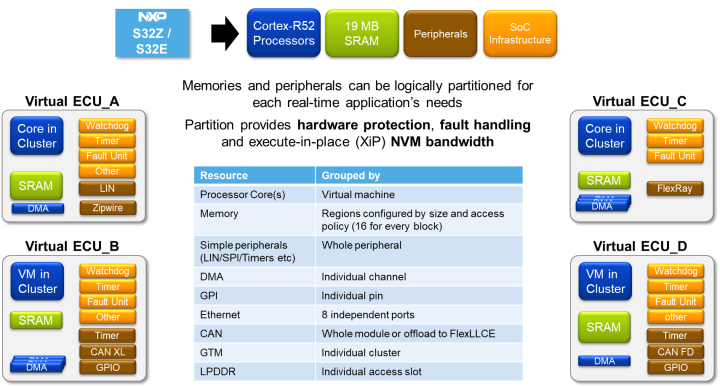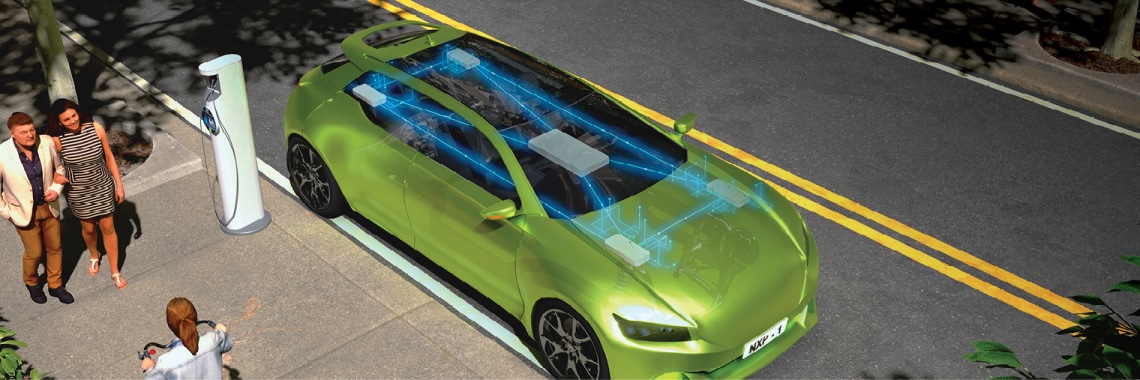NXP has just extended the
S32 Automotive Platform
by adding a new class of safe, real-time processors that offer the critical
deterministic behavior of safe microcontrollers (MCUs), but with an
unparalleled combination of gigahertz speed, multi-application isolation and
memory expansion capabilities. The new 16nm
S32Z and S32E real-time processor
families are ideal for the safe integration of cross-domain vehicle functions
for software-defined vehicles.
The S32 platform extension is significant because it allows NXP customers to
leverage the platform’s commonalities and benefits across their new vehicle
architectures such as Arm® Cortex® processor
cores, integrated hardware secure engine (HSE), ISO 26262 ASIL D functional
safety support and common software development environment with
application-oriented processor families.
S32G vehicle network processors
target vehicle computers and service-oriented gateways,
S32K general-purpose microcontrollers
target body domain and zonal applications and
S32Z real-time processors
target safety processing and real-time domain and zonal control applications.
Together, these devices support our customers diverse, end-to-end domain and
zonal vehicle architectures to enable the software-defined vehicles of the
future.
 NXP offers end-to-end solutions for vehicle infrastructure platforms.
NXP offers end-to-end solutions for vehicle infrastructure platforms.
But what is “real-time processing” and why is it important? In computing,
“real-time” describes operations that respond to events and must always be
completed within a specified time window. Otherwise, an application may not
work properly and operate unsafely. Real-time applications operate
consistently and predictably, so they are "deterministic" and complete
execution within a defined maximum time. In order to meet these timing
constraints, a processor core has to meet the performance requirement, offer
fast interrupt responses and provide deterministic execution, which maps well
to the Arm Cortex-R52 processor cores that are used in the S32Z and S32E
families of processors. The Cortex-R52 processor cores also support functional
safety and hypervisors which are needed for these safe, real-time
applications.
Learn how NXP supports the integration of diverse, real-time applications
for new vehicle architectures and software-defined vehicles.
Discover the
GreenBox 3 Development Platform.
The initial
S32Z2
and
S32E2
series that are sampling today include eight Cortex-R52 processors cores with
split-lock support that operate at up to 1 GHz. With the split-lock
capability, different configurations of the processor cores can be selected at
boot depending on the application needs. For example, there is support for
four lockstep pairs, two lockstep pairs with four non-lockstep processor cores
or all eight processor cores running in non-lockstep for maximum flexibility.
In the future, NXP will sample the S32Z1 series, which include four Cortex-R52
processor cores, for applications that require more performance than
traditional automotive microcontrollers for real-time applications
integration, but not as much as the S32Z2 series. This gives customers
scalability with two families of processors that are pin- and
software-compatible. The real-time processors will also scale into the future,
with even more performance and integration with 5nm products in the future to
offer a strong roadmap with software compatibility. NXP already has a
functional 5nm real-time procressor test chip today as the first toward these
future products.
 S32Z and S32E processors compatibility and scalability.
S32Z and S32E processors compatibility and scalability.
The S32Z processors are ideal for safety processing and domain and zonal
control. They can integrate diverse safety and vehicle control applications
such as vehicle dynamics and chassis control. The software-compatible S32E
processors offer additional complex timers and 3.3V/5V analog-to-digital
converters and 5V I/O, making them ideal for electric vehicle (xEV) control
and smart actuation applications.
The S32Z and S32E processors were designed to meet the needs of multi-tenancy
of real-time applications that support the move from a hardware-centric
approach of adding new functionality with boxes or electronic control units
(ECUs) to a software-defined approach with “virtual ECUs” running as software
tasks on a single, multi-core real-time processor. There is a wide range of
automotive real-time applications across the vehicle. They can be integrated
at various parts of domain and zonal architectures as shown below.
 Real-time application examples.
Real-time application examples.
The goal is to offer the isolation and freedom from interference between the
virtual ECUs as was provided by separate ECUs—this requires a new level of
hardware isolation that is offered by the S32Z and S32E processors with
“core-to-pin” hardware virtualization. This end-to-end virtualization support
ensures that each virtual ECU only has access and control to specific
processing, peripherals, memory and I/Os to ensure isolation and to support independent
responses to faults that do not impact other virtual ECUs. Additionally, the
hardware virtualization supports defined levels of quality-of-service with
respect to external memory access. The S32Z and S32E processors are ready to
support the new software-defined vehicle requirements.
 S32Z / S32E multi-application integration example.
S32Z / S32E multi-application integration example.
A good example of how virtual ECUs can be supported by the S32Z and S32E
processors is shown below with an “EV-on-a-chip” example where multiple ECU
real-time functions are integrated on an S32E processor.
 Example of Multi-ECU integration – propulsion domain controller.
Example of Multi-ECU integration – propulsion domain controller.
The 16nm S32Z and S32E processors’ speed of up to 1 GHz is a strong
competitive advantage versus competitors 28nm safe microcontrollers that
typically run in the 300-400 MHz range. This enables the S32Z and S32E
processors to support more complex real-time applications and higher levels of
software integration that require higher performance. The S32Z and S32E
processors’ capability to accelerate up to 24 CAN 2.0 and CAN FD interfaces
also provide significant advantages in being able to process a lot of CAN
traffic deterministically and efficiently without having to interrupt the
processor cores.
The ability to expand memory with LPDDR4 DRAM and flash memory also supports
larger applications and data that will be important in the future, including
support for machine learning and AUTOSAR® Adaptive Platform for
vehicle services and data sharing. These advantages can be leveraged with
standalone S32Z and S32E processors for new designs, as well as be used to
enhance the performance of existing ECUs that use a traditional automotive
MCU. The S32Z and S32E processors support scalability of new and enhancements
of older products.
In summary, the versatile NXP S32Z and S32E processors address a key need in
new vehicle architectures to consolidate diverse real-time vehicle
applications. They support key processing requirements to meet “real-time”
needs, provide the ability to safely isolate multiple applications and provide
acceleration and expansion capabilities to streamline today’s software
development needs and extend into the future with a strong roadmap of
software-compatible devices. They provide an ideal extension of the S32
Automotive Platform to offer a range of solutions for the software-defined
vehicles of the future.
2022 Embedded Award Winner
The S32Z and S32E Real-Time Processors have been recognized as the most innovative hardware solution with the embedded award 2022.









